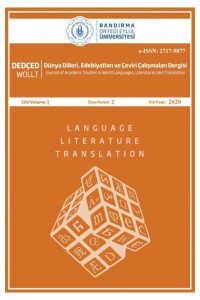Abstract
References
- Aker, A. (1972). İşçi Göçü. İstanbul: Sander Yayınları.
- Akgün A. (2015). Edebiyatımızda Göç ve Göçmen Edebiyatları Üzerine Bir Değerlendirme. Göç Dergisi, 2(1), 69-84.
- Asutay, H. (2017). Göçmen Edebiyatı. Edirne: Ceren Yayınları.
- Biricik, İ. (2017). Türk Romanında (1980-1990) Göçün Sosyolojik Etkisi: Ötekiler, Yeni Türk Edebiyatı Araştırmaları, 18(18), 59-74.
- Cengiz, S. (2010). Göç, Kimlik ve Edebiyat. Zeitschrift für die Welt der Türken (Journal of World of Turks), 2(3), 185-193.
- Chambers, I. (2014). Göç, Kültür, Kimlik. İstanbul: Ayrıntı Yayınları.
- Çağlayan, S. (2006). Göç Kuramları, Göç ve Göçmen İlişkisi. Muğla Üniversitesi Sosyal Bilimler Enstitüsü Dergisi, 17, 67-91.
- Ekici, S. ve Tuncel, G. (2015). Göç ve İnsan. Birey ve Toplum Sosyal Bilimler Dergisi, 5(1), 9-22.
- İlhan, N. (2015). Edebiyat Sosyolojisi Açısından Abbas Sayar’ın Romanları, Folklor/Edebiyat Dergisi, 21(81), 107-124.
- Mortan K. ve Sarfati M. (2011). Vatan Olan Gurbet Almanya’ya İşçi Göçünün 50.Yılı. İstanbul: İş Bankası Kültür Yayınları.
- Nazlıgül, N. (2007). Abbas Sayar’ın Romanları Üzerine Bir Araştırma. (Yayımlanmamış yüksek lisans tezi). Eskişehir Osmangazi Üniversitesi, Sosyal Bilimler Enstitüsü, Türk Dili ve Edebiyatı Ana Bilim Dalı, Eskişehir.
- Oymak, A. (2005). Almanya’daki Türk Edebiyatı/İlk Kuşak Yazarları ve Eserlerinin İncelenmesi. (Yayımlanmamış yüksek lisans tezi). Marmara Üniversitesi Türkiyat Araştırmaları Enstitüsü, Türk Dili ve Edebiyatı Ana Bilim Dalı, İstanbul.
- Sayar, A. (2002). Dik Bayır. İstanbul: Ötüken Yayınları.
- Şen, F. (ed) (2011). 50. Yılında Göç. Ankara: T. C. Kültür ve Turizm Bakanlığı Yayınları.
- Tomur, S. (2002). Klişelerden Uzak Bir Köy Romancısı: Abbas Sayar. (Yayımlanmamış yüksek lisans tezi). Bilkent Üniversitesi Ekonomi ve Sosyal Bilimler Enstitüsü, Türk Dili ve Edebiyatı Ana Bilim Dalı, Ankara.
- Yalçın, C. (2004). Göç Sosyolojisi. Ankara: Anı Yayınları.
- Yıldırımoğlu, H. (2005). Uluslararası Emek Göçü “Almanya’ya Türk Emek Göçü”. Kamu-İş Dergisi, 8(1), 1-24. 157
Abstract
People have migrated for various reasons throughout history. Migration, which does not lose its continuity even if its reasons change, is a universal and multidimensional phenomenon.The basis of migration is change of place, for a period of time or indefinitely. Migration, whose causes change and diverse over time, have consequences that affect societies. The German labor migration, which started with official agreements in the 1960s, had various effects on both communities. It is inevitable that literature, which has a strong relationship with social events and bases its subjects on a human basis, will focus on labor migration to Germany. The novel, which is a literary genre, includes the events affecting the society and the changes in social life due to its connection with human and society. Reflecting these changes and the effects of events on people in detail, novels establish a connection between society and literature. In Turkish literature, many works on German labor migration have been given. The novel Dik Bayır, first published in 1974, is one of these works. In this study, the novel Dik Bayır, which looks at the German labor migration from the perspective of the people left behind by the workers, will be analyzed through text analysis. The novel tells about the reasons why a Central Anatolian peasant became a worker in Germany and left behind. In the novel, Abbas Sayar gives detailed information about the establishment and operation of Village Development Cooperatives, which is one of the routes to Germany. This information is important because the period to give an idea about Turkey. At the beginning of the novel, it is told that the village of Beydiyar, which is a novel place, was settled by migration due to the 17th century Celali Rebellions. In other words, this is another migration story that started with migration. The novel is also important because it is one of the few works that describes the processing of those who survived the German labor migration in Turkish novel.
References
- Aker, A. (1972). İşçi Göçü. İstanbul: Sander Yayınları.
- Akgün A. (2015). Edebiyatımızda Göç ve Göçmen Edebiyatları Üzerine Bir Değerlendirme. Göç Dergisi, 2(1), 69-84.
- Asutay, H. (2017). Göçmen Edebiyatı. Edirne: Ceren Yayınları.
- Biricik, İ. (2017). Türk Romanında (1980-1990) Göçün Sosyolojik Etkisi: Ötekiler, Yeni Türk Edebiyatı Araştırmaları, 18(18), 59-74.
- Cengiz, S. (2010). Göç, Kimlik ve Edebiyat. Zeitschrift für die Welt der Türken (Journal of World of Turks), 2(3), 185-193.
- Chambers, I. (2014). Göç, Kültür, Kimlik. İstanbul: Ayrıntı Yayınları.
- Çağlayan, S. (2006). Göç Kuramları, Göç ve Göçmen İlişkisi. Muğla Üniversitesi Sosyal Bilimler Enstitüsü Dergisi, 17, 67-91.
- Ekici, S. ve Tuncel, G. (2015). Göç ve İnsan. Birey ve Toplum Sosyal Bilimler Dergisi, 5(1), 9-22.
- İlhan, N. (2015). Edebiyat Sosyolojisi Açısından Abbas Sayar’ın Romanları, Folklor/Edebiyat Dergisi, 21(81), 107-124.
- Mortan K. ve Sarfati M. (2011). Vatan Olan Gurbet Almanya’ya İşçi Göçünün 50.Yılı. İstanbul: İş Bankası Kültür Yayınları.
- Nazlıgül, N. (2007). Abbas Sayar’ın Romanları Üzerine Bir Araştırma. (Yayımlanmamış yüksek lisans tezi). Eskişehir Osmangazi Üniversitesi, Sosyal Bilimler Enstitüsü, Türk Dili ve Edebiyatı Ana Bilim Dalı, Eskişehir.
- Oymak, A. (2005). Almanya’daki Türk Edebiyatı/İlk Kuşak Yazarları ve Eserlerinin İncelenmesi. (Yayımlanmamış yüksek lisans tezi). Marmara Üniversitesi Türkiyat Araştırmaları Enstitüsü, Türk Dili ve Edebiyatı Ana Bilim Dalı, İstanbul.
- Sayar, A. (2002). Dik Bayır. İstanbul: Ötüken Yayınları.
- Şen, F. (ed) (2011). 50. Yılında Göç. Ankara: T. C. Kültür ve Turizm Bakanlığı Yayınları.
- Tomur, S. (2002). Klişelerden Uzak Bir Köy Romancısı: Abbas Sayar. (Yayımlanmamış yüksek lisans tezi). Bilkent Üniversitesi Ekonomi ve Sosyal Bilimler Enstitüsü, Türk Dili ve Edebiyatı Ana Bilim Dalı, Ankara.
- Yalçın, C. (2004). Göç Sosyolojisi. Ankara: Anı Yayınları.
- Yıldırımoğlu, H. (2005). Uluslararası Emek Göçü “Almanya’ya Türk Emek Göçü”. Kamu-İş Dergisi, 8(1), 1-24. 157
Details
| Primary Language | Turkish |
|---|---|
| Journal Section | Research Article |
| Authors | |
| Publication Date | December 30, 2020 |
| Submission Date | September 13, 2020 |
| Published in Issue | Year 2020 Volume: 1 Issue: 2 |

